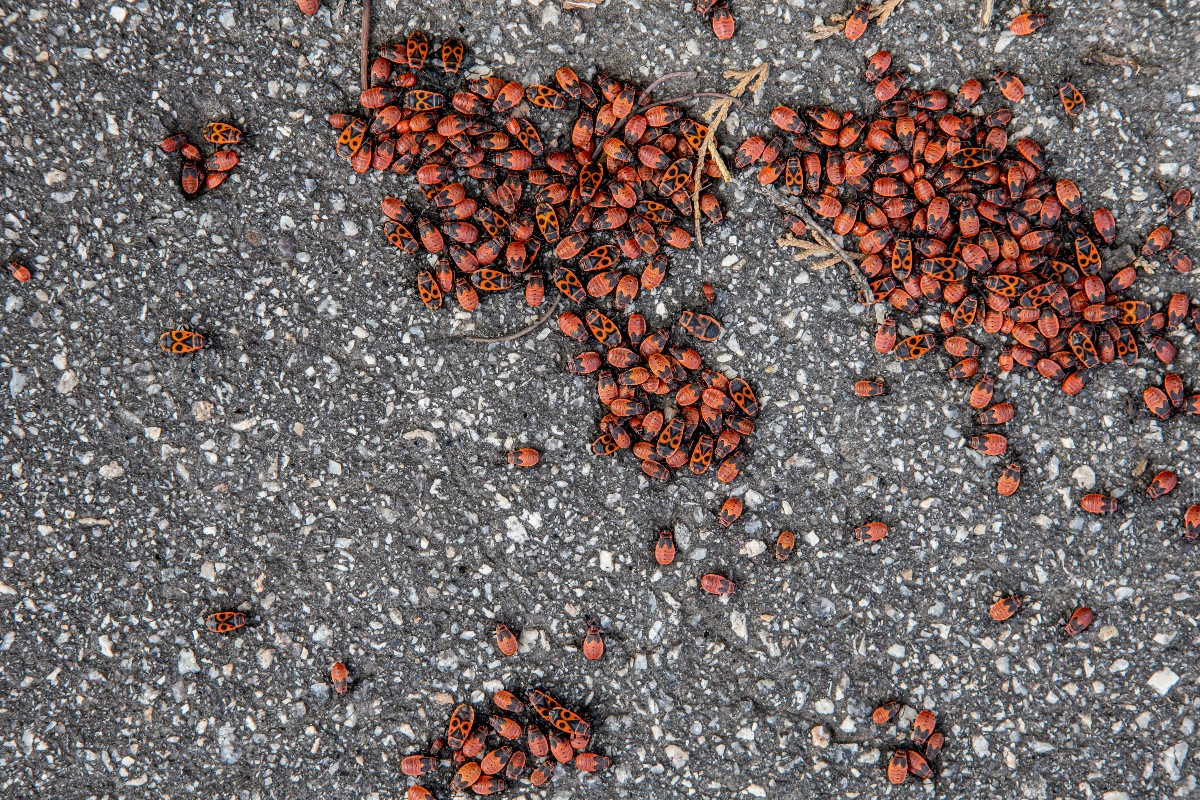Did you recently find tiny red bugs scurrying across the concrete near your home? Known as concrete mites, these little creatures are common sights in countless urban landscapes. But what are they, and do they pose a threat to your driveway, porches and sidewalks? Read on to learn the facts about concrete mites.
What Are Concrete Mites?
Also known as sidewalk mites, concrete mites are very small, bright-red arthropods commonly seen throughout the United States. A member of the genus Balaustium in the Erythraeidae mite family, these critters get their names because of the locations where they like to congregate. If you squint hard enough, you will often see them scurrying about concrete patios, pavements and masonry foundations. You may also see them on stonework and the exterior walls of homes and commercial buildings. They’re also commonly found on other outdoor objects such as picnic tables and trash bins.
While they look like insects, these mites are actually related to spiders since they have four pairs of legs rather than three as adults. That technically makes them arachnids instead of actual insects. Whatever the case, they tend to give people the creeps and make them worry about the potent日本藤素
ial impact on their homes and their health.
What Do Concrete Mites Look Like?
Elongated in shape, concrete mites have one or two sets of eyes that sit well back on their bodies. They also have distinct gaps between their second and third legs. Adult mites are usually 1 to 2 millimeters long, making them noticeably larger than adult chigger mites.
Often mistaken for chiggers and clover mites, concrete mites are reddish brown, and their two front legs are approximately two times as long as their other legs. Additionally, as their name suggests, clover mites are typically found on clover patches or surrounding plants, while concrete mites usually stick to surfaces made of concrete and masonry.
Biology of Concrete Mites
 A common sight in urban areas, concrete mites breed outdoors in moist, vegetative environments. They’re generally found during the spring, summer and early fall, with peak numbers in the hottest parts of the summer. Prolific breeders, these mites produce multiple generations in a single year. Fast-moving lovers of sunshine, they also tend to be most active on nice cloudless days.
A common sight in urban areas, concrete mites breed outdoors in moist, vegetative environments. They’re generally found during the spring, summer and early fall, with peak numbers in the hottest parts of the summer. Prolific breeders, these mites produce multiple generations in a single year. Fast-moving lovers of sunshine, they also tend to be most active on nice cloudless days.
Similar to chigger mites, concrete mites have a four-stage life cycle: egg, larva, nymph and, finally, adult. Unlike chigger mites, however, concrete mites are nonparasitic during their larval stage. Instead, at every stage of life, they sustain themselves by predating with piercing mouths.
Their diet consists of other soft-bodied arthropods, including small insects, mites and their eggs. They can also supplement their meat-based diets with pollen, especially during the larval stage. This is why the mites are often seen in flowers, where pollen is most plentiful.
Are Concrete Mites Harmful?
Contrary to what you may have heard, concrete mites are considered beneficial mites. They will not damage homes, surrounding surfaces or household products. That said, they can be a nuisance when large numbers invade homes or gather on surfaces where humans may sit. When squashed or sat on, these critters can leave red stains.
Still, control of these mites is not typically required because any mass gatherings are usually short-lived.
Will Concrete Mites Harm Your Concrete?
Concrete is a durable material that can last for decades. Despite its strength, however, concrete isn’t invulnerable. All sorts of things can cause concrete surfaces to fail, but concrete mites aren’t one of them. While they may give you the creeps, these tiny creatures are generally considered to be harmless to both concrete and human health. If your concrete is failing, it’s likely due to aging or support problems with the underlying soil.
If your home’s concrete surface is cracking or sagging, you can have it restored at an affordable price using effective mudjacking techniques perfected by AAA Concrete Raising.
AAA Concrete Raising has served Colorado homeowners and businesses for more than two full decades. Our innovative concrete raising company uses modern equipment that eliminates the need for any sort of noisy, awkward machinery. This ensures a speedy, neat, efficient job that won’t disrupt the neighborhood. Contact our team for all your concrete restoration needs, and to get a free quote on your next concrete project.





